
What's your opinion on this article?
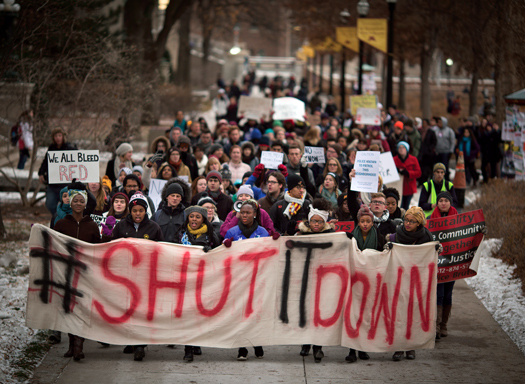
Students rally in support of victims of police brutality at the University of Minnesota in Minneapolis, Nov. 25. Rallies were held nationwide to demonstrate against the grand jury's decision in Ferguson, Mo., and in an effort to show solidarity with Michael Brown, the unarmed Black teenager shot and killed by Ferguson police officer Darren Wilson.
|
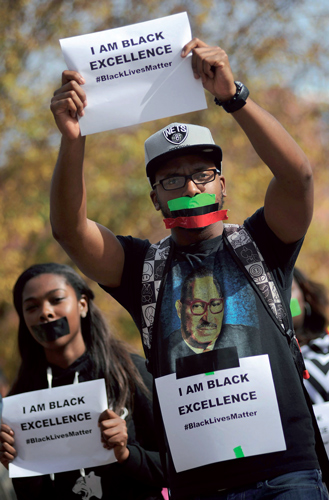
Students at Jackson State University participate in the national Hands Up Walkout on Dec. 1, at the Gibbs-Green Plaza on the school’s Jackson, Mississippi, campus. Protesters across the U.S. have walked off their jobs or away from classes in support of the Ferguson protesters. Photo: AP/Wide World Photos
|
Black Friday and shopping Saturday was bleaker for some shoppers as demonstrators marched, shouted and sometimes confronted store employees and owners over the Nov. 28 weekend. Most of the time shops started to lock doors, pull down shutters and activate gates as soon as the chanting started. Young people, primarily Black but with some White and older participants, strode through malls and stores with their hands up and sometimes holding signs.
“Black lives matter!” they shouted.
“Shut it down,” chanted a 62-year-old Black woman, walking with a cane and accompanied by an older man and a child as the protesters entered the Sears store at a suburban St. Louis mall as she exited.
“It makes me feel real good. They need to do this more. They treating the Black people any kind of way now everybody is pitching in,” said the woman from St. Louis, who preferred not to give her name.
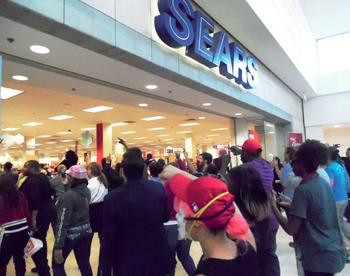
Young people converge on a Sears store during Black Friday protests. Photos: Richard Muhammad
|
The protests are another level of action to protest the killing of Black teenager Michael Brown, who was unarmed, by White officer Darren Wilson, who has now resigned. The demonstrators have been going on for over 115 days and emotions and anger peaked again Nov. 24 when a county prosecutor announced a grand jury had found no reason to indict Officer Wilson for any wrongdoing.
Protestors took to the streets here and other cities across the country with the announcement. There was some unrest and arrests made as crowds massed again across the street from the Ferguson Police Dept. headquarters. There was tear gas and armored vehicles in the streets at times.
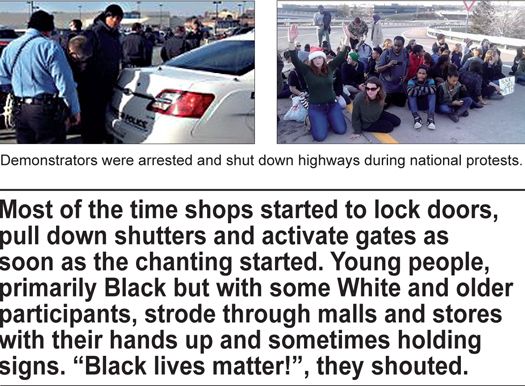
|
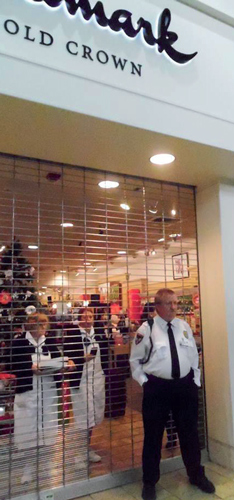
Security officer outside closed business at St. Louis area mall.
|
The shut ’em down strategy is another sign of the determination of protestors and the growth of organizations created and led by Black youth since Aug. 9, the day young Brown was shot to death and his body lay in the streets for four and a half hours.
The actions were swift, disciplined, peaceful and effective. It cost businesses shopping time and purchases, with some White shoppers fleeing crowded malls as the demonstrators showed up. State, city and county governments and police officers worked over and zipped from guerilla protest to guerilla protest. The governor of Missouri has already asked the state legislature for more money to cover the costs of having the National Guard on the streets and other expenses.
Some shoppers raised both hands above their heads in the “don’t shoot” position, raised clinched fists, gave the thumbs up sign, or honked their horns in support. Cell phone cameras were pointed at demonstrators and some shoppers followed protestors or joined their protest march through the mall.
Protests have moved from a commercial strip near where Michael Brown was shot to other places that are Whiter, richer and perhaps more removed from America’s racial divide and America’s racial realities.
“We decided if Mike can’t shop, nobody can shop. If Mike’s parents can’t come buy his Christmas presents, other peoples’ families can’t come buy their Christmas presents,” said Alexis Templeton, 20, co-founder of Millennial Activists. The group was started by three young Black women who were on the frontlines in the early days of protests. They have not stopped, but they have grown stronger, smarter, more disciplined and intensely focused.
“We came to shutdown the mall and that’s what we did,” she said. People were made uncomfortable and made to realize it’s not about materialism and property, Alexis said. “It’s about Black lives that matter.”
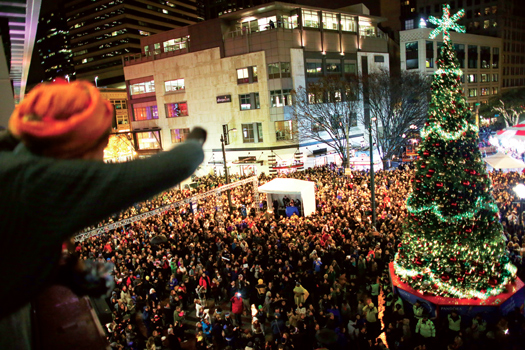
A protester looks out over a sea of people at Westlake Center where Ferguson protesters disrupted the annual tree lighting, Nov. 28, in Seattle. The tree was still lit but the mall closed after a few hundred protesters forced their way onto the upper level stage where carolers and other performers were to perform. Photo: AP/Wide World Photos
|
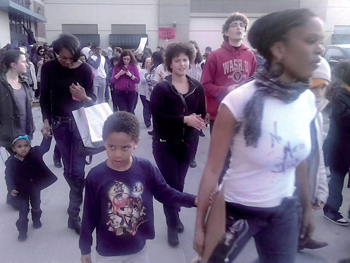
Ferguson, Mo. demonstrators leave after shutting down mall during Black Friday protests. Photo: Richard Muhammad
|
At the protests, youth occupied streets and blocked highway ramps with a 4-5 minute die-in. They lay on the ground for several minutes to represent the four and half hours young Brown’s body lay in the street in the heat of August.
There are also increased efforts to pressure political figures who failed to properly handle the crisis and give justice, said activists.
Anthony Shahid, dressed in a Klan-style robe, led a Saturday protest in Clayton, Mo., a center for government and law enforcement in St. Louis County, Mo., which he declared was “KKK Klayton.” The town is home to the office of controversial county prosecutor Bob McCullough, who activists and Black lawyers blasted for using the grand jury process to avoid charging Officer Wilson. It is also the home of county courts and what activists renamed the “Injustice Center,” as opposed to the Buzz Westfall Justice Center.
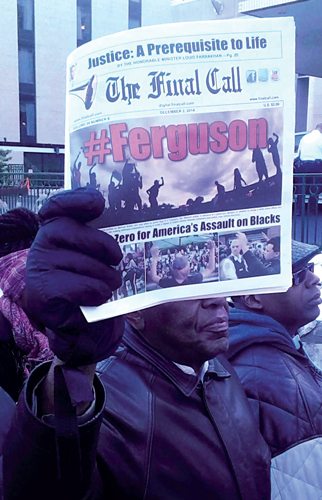
Final Call cover on display in Clayton, Mo. Photo: Richard Muhammad
|
“We want President Obama to come here. We want 100,000 people to come here in two weeks,” said Mr. Shahid, who is part of the Leadership Coalition for Justice and an advisor to the parents of Michael Brown.
The group marched through the streets and stopped at a Crown Plaza Hotel that reportedly closed its doors to a young man who tried to use a restroom.
“Are we back to this?” shouted Mr. Shahid, as Clayton police officers and county officers stood in front of the hotel’s sliding doors.
Dr. Lisa Brock, a 58-year-old college professor from Chicago, called Ferguson “the epicenter of a new possibility for growing movement because all African Americans have been impacted by this and the response nationally illustrates we’ve all felt this pain. It’s open season on Black folk. White fear, which is really hallucinatory, has become a legal argument now,” she said standing across the street from the Ferguson Police Dept.